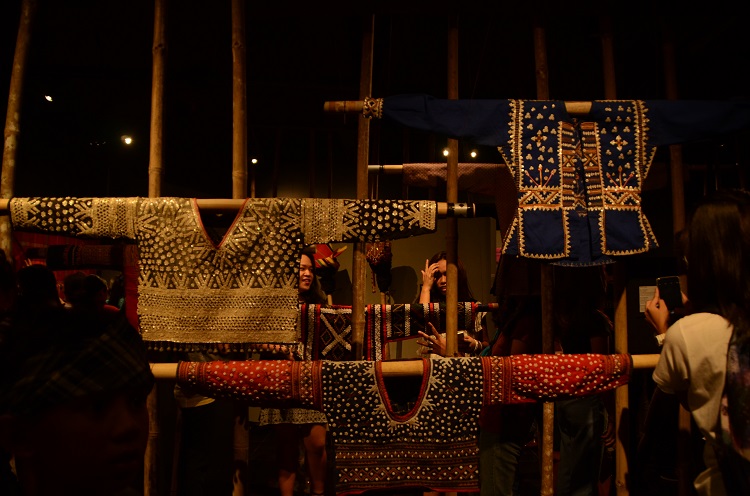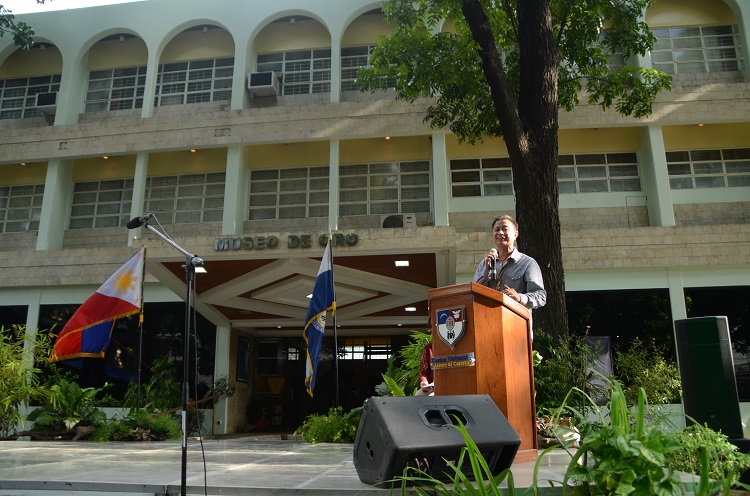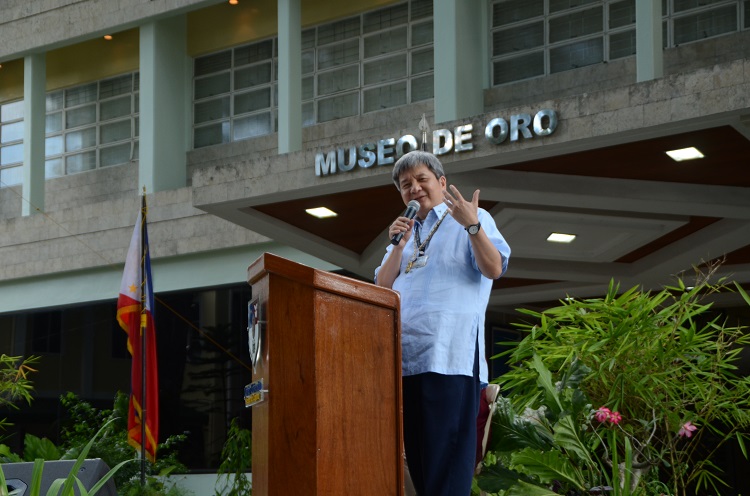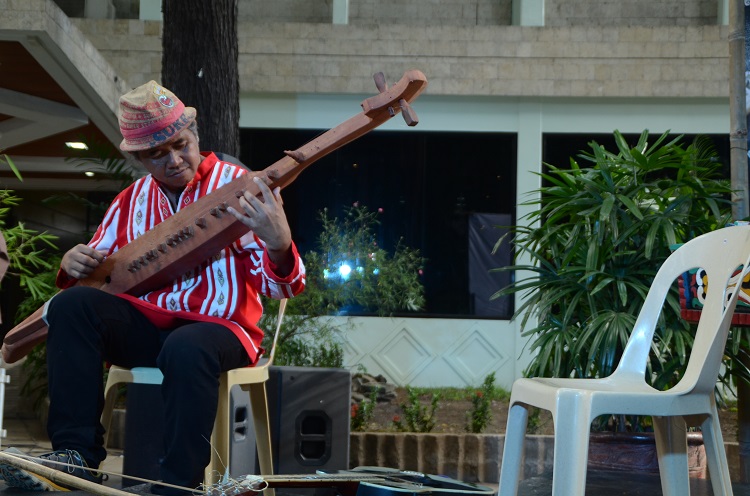HABING MINDANAO. The Habing Mindanao – Cloth and Textile Traditions of Southern Philippines (as part of the Kabuwadan – Gifts from Generations) provides glimpses of the diversity of indigenous garments in the regions’ sacred and notable history.
Text by Angelo Lorenzo
Photos by Alex Belen
The Museo de Oro under the banner of the Xavier Center for Culture and the Arts (XCCA), together with the National Commission for Culture and the Arts (NCCA), celebrated the National Heritage Month through a display of southern Philippines’ clothing and textile.
Under the curatorship of Ramon Magsaysay Memorial Colleges’ artistic director professor Leonardo Cariño and set in time for the International Museum Day, the Habing Mindanao – Cloth and Textile Traditions of Southern Philippines (as part of the Kabuwadan – Gifts from Generations) provided glimpses of the diversity of indigenous garments in the regions’ sacred and notable history.
In the ribbon-cutting ceremony on Thursday, May 18, in front of Museo de Oro, Xavier Ateneo president Fr Roberto C Yap SJ emphasized the importance in preserving the Mindanaoan identity symbolized by indigenous clothing and textile.
“We are all Filipinos, but as we are here in Mindanao, we also celebrate our being Mindanaoan. I think part of that celebration, part of our identity and culture is very much embodied in the textile and clothing,” he said.
Yap went on by saying that Mindanao’s culture and heritage are marked by them. “That is why I think this exhibit is very important and relevant,” he added.
Museo de Oro curator Dr Erlinda M Burton also agreed with Yap, “This month has a great significance to the nation and its people for this is the time when we can look back and see what our past cultures have left and still imprinted in our memories.”
Burton, whose archaeological discoveries in regions of Mindanao have been compiled in extensive research works, expressed the importance of the exhibit to memorialize and introduce the diverse clothing as part of the tribes’ cultures and woven by traditional practices in an age where Western fashion garbs are the preferences of modern-day consumers. “May this exhibition stimulate appreciation and love for our national heritage,” she said.
CULTURAL PRESERVATION. Ramon Magsaysay Memorial Colleges’ artistic director professor Leonardo Cariño, who was formerly a member of the National Committee on Cultural Education and the Visual Arts Committee of NCCA, emphasizes on cultural preservation as the primary reason for the exhibit and his undying passion to collect indigenous textiles.
Indigenous classifications
Exhibited within Museo de Oro’s Fr Franscisco Demetrio SJ Gallery, the clothes were manually woven, delicately beaded, and masterfully embroidered by local artists and members of the indigenous communities.
Transported all the way from Davao del Sur, the blouses of the Tagakaolo and Blaan Mahin tribes are hung over varnished bamboos while from the Saranggani and Basilan provinces, the men’s customary trouser, sawal from the Yakan, Tagakaolo, Blaan, and Bagobo tribes are also displayed.
Woven with authentic cotton and silk is the Maranao’s Malong Andon. The works of the Gawad sa Manlilikha ng Bayan (GAMABA) included Ambalong Ausalim’s Pinalantupan fabric, Lang Dulay’s T’nalak from the Tboli, Salinta Monon’s Inabal from the Bagobo, and Yabing Dulo’s Tabi from the Blaan.
More garments and fabrics collected by Cariño are displayed and are divided in five sections. One display exhibited the similarity of cloth and textile decorative techniques of Mindanao by outlining them with threads on the island’s map. Despite the diversity of clothing styles, the process of weaving them are completed similarly with abaca, cotton, pineapple, and silk fibers.
FILIPINO IDENTITY. “We are all Filipinos, but as we are here in Mindanao, we also celebrate our being Mindanaoan. I think part of that celebration, part of our identity and culture is very much embodied in the textile and clothing,” says Xavier Ateneo president Fr Roberto C Yap SJ.
Weaving Mindanao
Cariño, who was formerly a member of the National Committee on Cultural Education and the Visual Arts Committee of NCCA, highlighted cultural preservation as the primary reason for the exhibit and his undying passion to collect indigenous textiles.
“Exhibitions are better seen and experienced, rather than talked about,” he mentioned as he invited everyone from the Xavier Ateneo community to CDO residents to visit the display and learn about the various clothing and garbs worn by the original inhabitants of Mindanao.
CDO City Mayor Oscar Moreno graced the opening with a statement, “The task of nation-building is everybody’s concern.” He also pointed out that learning to appreciate the region’s history just by the glimpse of these clothing is one way to accomplish this.
XCCA director Hobart Savior explained that Weaving Mindanao (one of the closest translations for Habing Mindanao) extends beyond witnessing the tribes’ clothing and garments but one that stitches unity.
“If only and when our differences in our aspects of politics, religion, ideology, worldview, gender, race, social status, and voice can be woven and shuttled again strand by strand with care and respect, and void of any politics of exclusivity and corruption, single-mindedness, misinformed truths, we can attain what we ideally aspire for others, especially the marginalized and for ourselves especially if we wish to live in a peaceful environment,” said Savior in his message.
The opening reception also included performances by the XU Cultural Dance Troupe, XU Glee Club, and Waway Saway, the notable Mindanaoan music artist famous for his indigenous and culturally-enriched songs.
The exhibit runs until June 18 this year. ∎
WAWAY SAWAY. The opening reception features a presentation of Waway Saway, the notable Mindanaoan music artist famous for his indigenous and culturally-enriched songs.



